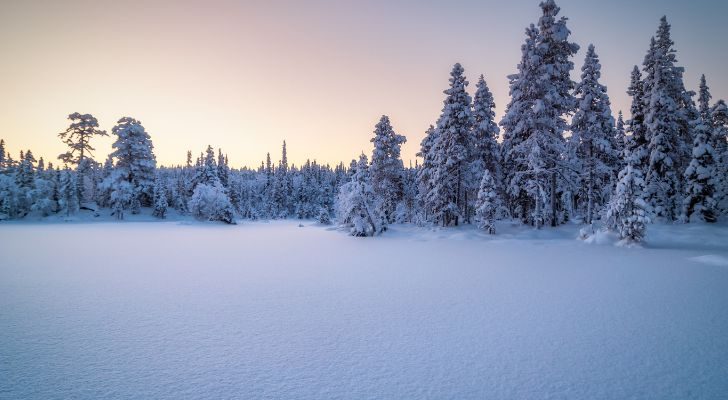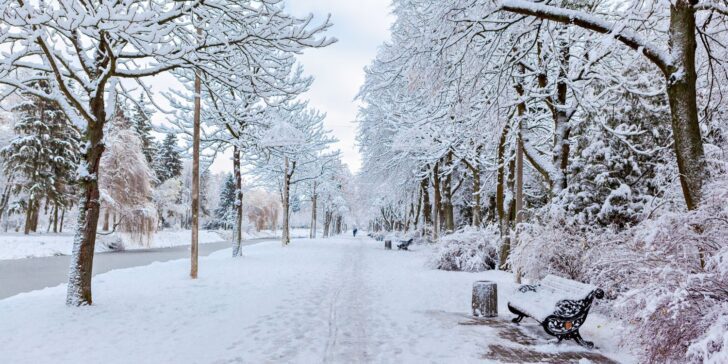Snow may be the only thing on Earth that is simultaneously enchanting and annoying, completely necessary and extremely dangerous.
But no matter if you love or hate it, or both at the same time, snow is an essential part of the Earth’s ecosystem.
Let’s consider some of the more unusual aspects of snow!
Scientists classify snow as a mineral, the same as salt or diamond: a naturally occurring solid inorganic material with a definite chemical composition and an ordered atomic arrangement.
Snowflakes are composed of ice crystals. A crystal is any matter in which ions, atoms, or molecules are arranged in a highly ordered three-dimensional lattice.
In fact, the word “crystal” comes from the Greek krustallos, which means not only “rock crystals” but also “ice.”
The largest single ice crystal ever documented measured just 0.39 inches (1 centimeter) from tip to tip. Most are much smaller than that.
Although a single airborne ice crystal is very tiny, it clusters with others as it falls to form snowflakes. An ordinary snowflake may consist of dozens or even hundreds of crystals clumped together.
The largest snowflakes ever documented fell on January 27, 1887, at Fort Keogh in Montana, USA. They measured fifteen inches (38 cm) wide and eight inches (20 cm) deep.
Google commemorated the 125th anniversary of this remarkable snowfall event with a doodle depicting a giant cartoon snowflake crushing the landscape as it fell.
The individual shape of a snowflake is based on air temperature, humidity level, speed of descent, and direction of movement as the snowflake falls.
Snowflakes are nearly always six-sided, though they can also have three or twelve sides. Their shapes fall into seven basic shapes: stars, needles, dendrites, plates, columns, columns capped with plates, and irregular (or damaged).
Chemistry teacher Andy Brunning subsequently discovered that those seven basic shapes result in 35 different sub-variations of snowflake shapes. He found that needle-like crystals form at 28°F (-2.2°C), while flat crystals form at the lower temperature of 23°F (-5.5°C).
The declaration that no two snowflakes are alike arose from photographer Wilson Bentley, who became the first person to photograph a snowflake in 1885. He subsequently photographed over 5,000 snowflakes throughout his lifetime and never found any duplicates.
Snowflakes can be identical, though, as discovered by Nancy Knight in 1988 as she studied high-altitude cirrus clouds. She flew through a snowstorm and collected snowflakes on chilled glass microscope slides covered with sticky oil. While observing them under a microscope, she actually found two snowflakes that were, for all intents and purposes, identical.
Snow is just one of several different forms of precipitation. Other types include rain, sleet, graupel (soft hail), and hail.
The word “graupel” comes from the German word graupe, meaning “pearl barley.”
Frost is not considered snow or precipitation because it’s formed from water already on the ground.
It can never be too cold for snow to form.
It’s been calculated that a typical snowflake takes about one hour to fall to the ground, descending between 1 and 4 mph (1.6 – 6.3 kilometers per hour), depending on conditions.
Key West, Florida, is the only place on record in the continental U.S. where it has never snowed. The lowest temperature ever recorded there was 41°F (5°C) on January 12, 1981.
Which US state is the snowiest? Surprise! It’s Vermont, followed by Maine, New Hampshire, and Colorado. Alaska comes in 5th. Not surprisingly, Hawaii and Florida are at the bottom of the list.
A blizzard differs from a snowstorm, just as a hurricane differs from a tropical storm. For a storm to be classified as a blizzard, winds must be at least 35 mph (56 km/h), with snowfall heavy enough to drop visibility to a quarter mile or less (0.4 km) for at least three hours.
A “ground blizzard” is when it’s not snowing, yet strong winds blowing loose snow lowers visibility.
There are an average of 105 snow-producing storms annually in the U.S., each typically covering multiple states and lasting several days.
A well-known rule of thumb is that ten inches (25.4 cm) of snow equals one inch (2.54 cm) of rain. This turns out to be an inaccurate myth, as the water content of any snowfall varies significantly according to conditions. It may be as high as the 100-to-one ratio for light, fluffy, cold snow or as low as four-to-one for warm, dense, wet snow.
Fresh snow is an excellent insulator. Ten inches of fluffy fresh snow can be as low as seven percent water and 93 percent air. The insulation value is approximately equal to a six-inch layer (15.2 cm) of R-18 fiberglass insulation. This is why many animals burrow deep into the snow during winter to hibernate.
Snow falling through the air picks up nitrogen, a good fertilizer for plants and trees, which is released to the soil when the snow melts. Snow insulates the roots of dormant plants and protects them from temperature swings, acting like mulch.
The largest snowplow blade in the world was manufactured in 1992 for use at JFK International Airport in New York City. The blade measured 50 feet long (15.3 m) and 4 feet high (1.23 m).
Syracuse, New York, is regularly on the list of “snowiest cities in the U.S.,” along with the nearby towns of Buffalo and Rochester, New York, and Erie, Pennsylvania. All these areas suffer from “lake effect snow” coming off Lake Erie, which often dumps upwards of 100 inches (2.54 m) or more of snow throughout the region each season.
On March 30, 1992, after a particularly harsh and snowy winter, the Syracuse Common Council officially outlawed further snowfall until December 24, 1992. Alas, it snowed several inches just two days later.
An avalanche cannot be triggered by noise. Gunshots, singing, yodeling, and supersonic booms will have no effect. The only trigger is a shift in the weight of the snow load, either by more snow falling or melting, a shift in the wind, or the added weight of a skier or snowmobiler.
The Ski-Doo snowmobile, first released in 1959, was originally supposed to be called the “Ski-Dog.” However, there was a typo in the first batch of brochures, and the company decided to roll with it.

Like it or not, snow is unavoidable and essential in many parts of the world.
If you love skiing, white Christmases, and winter wonderlands, then you’re sure to appreciate it, even if it means shoveling the driveway.
Now you can impress your soggy and sodden snow-bound friends with these fabulous facts about snow!


















